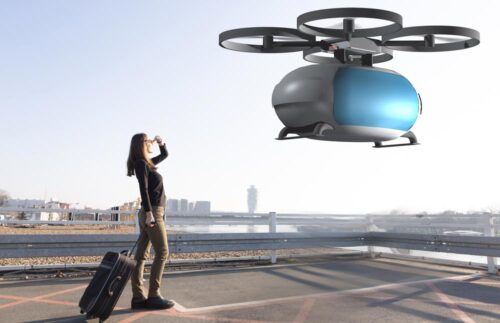How Arena Helps Nascent UAM Industry Take Flight
 In 1962, who would’ve thought the animators from Hanna-Barbera Cartoons in Los Angeles were already experimenting with urban air mobility (UAM)? Their cartoon, “The Jetsons” was living proof digital transformation was just around the corner.
In 1962, who would’ve thought the animators from Hanna-Barbera Cartoons in Los Angeles were already experimenting with urban air mobility (UAM)? Their cartoon, “The Jetsons” was living proof digital transformation was just around the corner.
The cartoon sitcom featured a futuristic space-age family living in Orbit City. “The Jetsons” invited its viewers to envision the incredible possibilities that the current wave of technological innovation could one day materialize—from robotic maids, flying cars, smartwatches, and video calls, to flat-screen TVs—all commonplace by today’s standards.
Even Hyundai Motor Group’s recent prototype flying taxi featured in this year’s Farnborough International Airshow in the U.K. calls to mind George Jetson’s aero-car with the clear bubble top he drove to work.
What’s propelling the UAM market?
With the increasing concerns for a sustainable environment, smart city initiatives for urban infrastructure, and a demand for alternative modes of transportation within municipalities, the UAM industry is projected to grow from USD 2.6 billion in 2022 to USD 28.3 billion by 2030.1
On a faster track, the Europe UAM market is projected to grow at the highest rate during the forecast period of 3 to 7 years with Germany, the U.K., and France investing heavily in developing and procuring advanced UAM systems for commercial operations.
In the Asian market, the Jeju Island in South Korea recently announced that tourists will be able to hop on a UAM or air taxi to shuttle to major tourist spots using coastal routes between three heavily frequented locations in Jeju by 2025.2
Arena debuts at BAM Forum
In September, Ann McGuire, Director of Product Marketing for Arena, a PTC Business, was invited to speak at the “Business of Automated Mobility Forum: Flight Path to UAM.” Attendees heard from industry experts on current regulatory and operational updates along with automated aircraft development and production, aircraft management, and operations as well as uncrewed aircraft system traffic management (UTM), safety and security, remote pilot technology, and autonomy.
Ann’s virtual presentation focused on the challenges of compliance, product complexity, and how Arena’s product lifecycle management (PLM) and quality management system (QMS) solutions can bring product development information and quality processes together in a unified platform to simplify compliance and accelerate time to market for UAM manufacturers.
Here are a few highlights from Ann’s presentation:
Compliance is a challenge
UAM developers strive to innovate and produce the safest, most efficient aircraft at an affordable cost that meets compliance standards. These highly complex UAM products need to meet evolving federal, state, and local safety standards for market acceptance.
Earlier in the year, the European Aviation Safety Agency (EASA) made history by becoming the first regulatory authority worldwide to publish a regulation for the operation of air taxis in the urban environment. The industry claims that this will support the European Commission’s effort to create “smart, green, and digital cities” as more manufacturers move ahead with plans to get their vertical takeoff and landing (VTOL) capable aircraft certified within a few years.
Ann believes Arena can help. She said, “We can’t manage all the elements that are being regulated in this new industry, but the two that we can manage are process and product standards. We can help define, revise, and meet product requirements as well as control design inputs linked directly to your deliverables.”
Ann noted, “We can manage product complexity by providing one accurate source of product information for the entire product team, including your global supply chain. And we can help you comply with evolving regulations and maintain a history of product design inputs, processes, decisions, and changes. That’s where Arena can help.”
Managing product complexity with product-centric quality management
Another challenge facing the UAM industry is product complexity. Building multi-electric-powered rotors or fan-driven type aircraft requires a surplus of parts, or custom-designed parts —from electrical and mechanical to software, each with its own set of challenges.
Engineers are not only dealing with a multitude of different parts but also many suppliers. What ends up happening is each engineering group segregates information into its own silo resulting in data and information living in spreadsheets or homegrown databases.
Ann said, “The solution Arena offers is product-centric quality management. It’s quality management for product companies. All the product information revolves around the bill of materials (BOM). The BOM includes the approved manufacturer’s list, the drawings, and the test results. The BOM is what we use as a foundation.”
Ann specified, “Our PLM solution manages all the products and then the changes to the products throughout the product lifecycle. The product-centric quality management software works with PLM to streamline processes, especially the quality management processes.”
“As an example, you can have a corrective action and preventive action (CAPA) that is linked directly with the parts that are being corrected. Once we have all the information in place and linked, there are going to be ongoing processes like engineering change orders and deviations related to manufacturing issues. Arena automates in a single platform to streamline and standardize your product and quality processes,” added Ann.
A new flight path on the horizon with PLM and QMS solutions
 Arena has several aerospace and defense customers using PLM and QMS solutions to help them develop safe, innovative, and compliant products. Aerospace and defense markets are challenging because they demand quality, product development efficiency, technological innovation, and regulatory compliance.
Arena has several aerospace and defense customers using PLM and QMS solutions to help them develop safe, innovative, and compliant products. Aerospace and defense markets are challenging because they demand quality, product development efficiency, technological innovation, and regulatory compliance.
For aerospace companies that fall under International Traffic in Arms Regulations (ITAR) and Export Administration Regulations (EAR), Arena PLM for AWS GovCloud offers a secure product development solution for these regulated businesses needing a proven cloud platform tailored to their business procedures. Arena PLM for AWS GovCloud enables government customers and their partners the freedom to leverage a cloud product development solution and abide by ITAR and EAR standards.
It’s been 60 years since the animators at Hanna-Barbera created the futuristic “Jetsons” with all their automated gadgets and flying cars. While audiences of the cartoon still marvel at their technological prophecies, one thing is for sure, we’re catching up, fast.
As more cities and urban areas adopt George Jetson-like air taxis and VTOL-capable aircraft, the opportunity for Arena to help the UAM industry take flight is exciting.
Learn more about product development for regulated companies.
Resources
1. Urban Air Mobility Market
https://www.marketsandmarkets.com/Market-Reports/urban-air-mobility-market-251142860.html?gclid=CjwKCAjw5P2aBhAlEiwAAdY7dBgbjawzsO_IAkJvxsJDCagOrZbaLKpxkvOWyMq1OOFJIlZ_rgqZahoCPX0QAvD_BwE
2. South Korea’s Jeju Island plans air taxi UAM services in 2025
https://dronedj.com//2022/08/26/jeju-air-taxis-uam/


